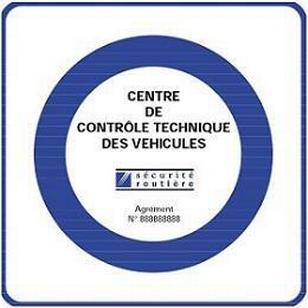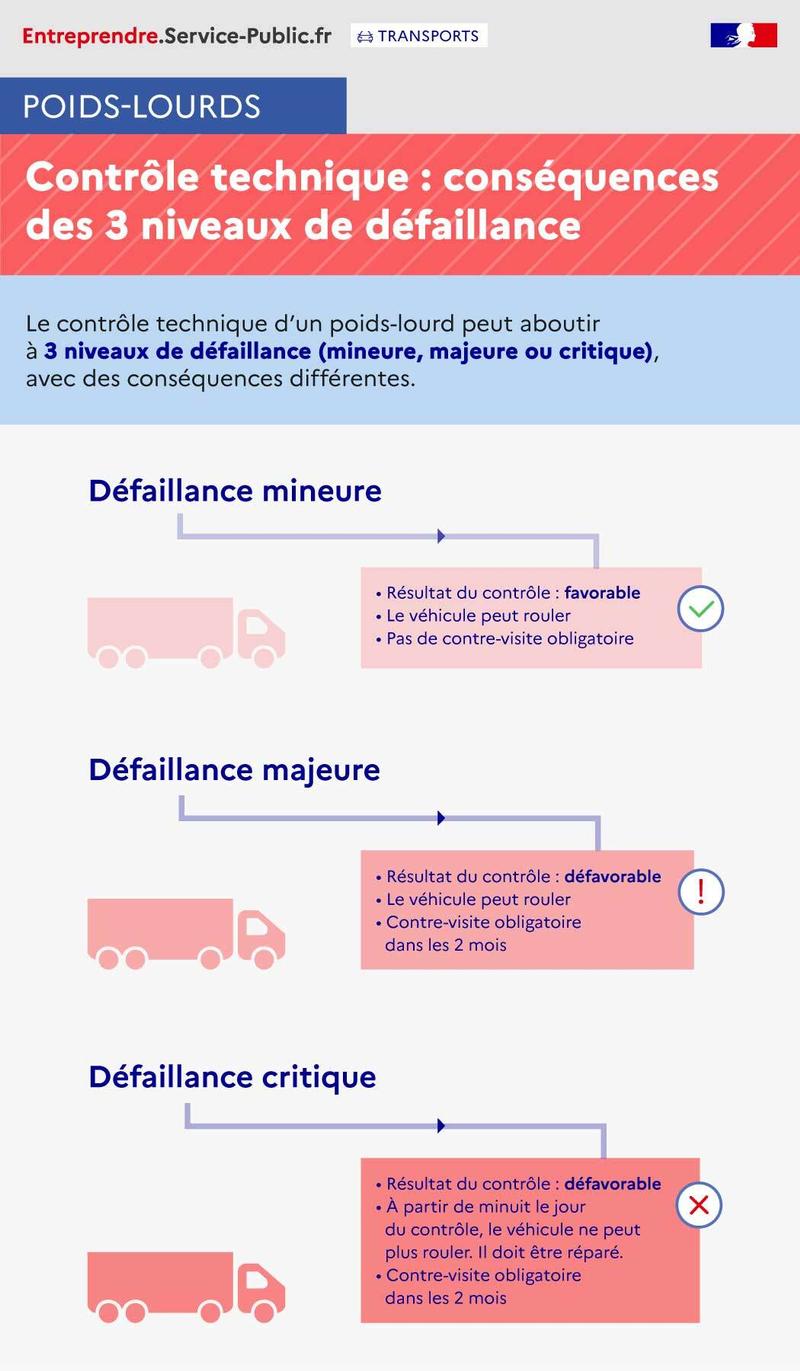Technical inspection of goods transport vehicles (TRM) and passenger vehicles
Verified 20 August 2025 - Directorate of Legal and Administrative Information (Prime Minister)
The technical inspection is mandatory for all road freight vehicles (TRMs). It has to be done 1 time per year. For public passenger transport vehicles, it must be carried out every 6 months. It's the owner the vehicle which must initiate the inspection and pay the costs. We explain when and how perform it.
Summary: technical inspection dispensed or mandatory depending on the type of vehicle
Type of vehicle | Mandatory technical inspection? |
|---|---|
Yes | |
Heavy-duty vehicle (more than 3.5 tons of PTAC: titleContent) | Yes |
Vehicle of collection used as a chauffeur-driven transport car (VTC) | Yes |
Vehicle of collection put into circulation before 1960 and with a maximum TAC of 3.5 t | No |
Vehicle of collection with a TAC of more than 3,5 t | No |
Agricultural tractor | No |
Trailer with a TAC of 3.5 tons or less not used for the transport of dangerous goods | No |
Trailer with a TAC of 3.5 tons or less used for the transport of dangerous goods | Yes |
Vehicle circulating with a W garage certificate | Yes |
Depending on the weight of the vehicle
A truck is a vehicle of more than 3.5 tons (PTAC: titleContent).
These may be vehicles used for public transport (categories M2 and M3) or for the transport of goods (categories N2 or N3).
You can refer to the list of all vehicle categories.
FYI
The agricultural tractors are exempt from it. Vehicles of collection also, regardless of their weight, unless the vehicle is used in the course of a VTC: titleContent.
Depending on the type of transport
All trailers, all vehicles towing trailers and all vehicles carrying dangerous goods are concerned, regardless of their weight.
Categories of vehicles concerned by the roadworthiness testwhatever their weight, are the following :
- Tractor units (TRR), regardless of PTAC, used to tow semi-trailers and trailers
- Trucks (CAM)
- Front-wheel semi-trailers (SRAT)
- Semi-trailers (SREM)
- Road trailers (REM)
- Combined Transport Semi-Trailers (CCTS)
- Combined transport trailers (RETC)
- Specialized Motor Vehicles (VASP)
- Specialized semi-trailers (SRSP)
- Specialized trailers (RESP)
- Passenger Transit Vehicles (PTAs)
- Vans (CTTE) used in public transit
- Vehicles used in the transport of dangerous goods and having a certificate of approval (all types and whatever the PTAC)
- Vehicles having a W certificate (garage card).
Please note
Vehicles having a W certificate (garage card) are now subject to mandatory technical inspection.
The periodicity of the roadworthiness test of a heavy goods vehicle differs according to whether it is a transport of people or goods.
People
Public transit (TCP) involves vehicles with more than 9 seats, including the driver's seat.
You must carry out the technical inspection of your vehicle every 6 months.
Please note
The VTC: titleContent and taxis are therefore not concerned. For them, the periodicity of the technical inspection is 1 time per year.
Goods
For the road transport of goods (TRM), you must carry out the technical inspection of your heavy goods vehicle 1 time per year.
If you do not carry out the recommended repairs following the inspection, or if you forget to carry out the technical inspection of your vehicle within the mandatory period, you risk sanctions.
In case of inspection by law enforcement, if you have not carried out the technical inspection within the mandatory period, you will have to pay a fine.
The amount of the fine differs depending on whether you own the car as a natural person or as a business.
- For an individual contractor, the fine is €750.
- For a business (legal person), the fine is €3,750.
The police officer issues a record of provisional circulation of 7 days for the purpose of performing the missing roadworthiness test.
He shall confiscate the certificate of registration (-) until proof of the roadworthiness test has been carried out.
Depending on the condition of the vehicle, it may also be immobilized in a technical inspection center or impounded.
You have to do the technical inspection in a special center, called approved center, which has a specific authorization for heavy goods vehicles.

Each approved center shall have the following logo:
The list of approved truck roadworthiness testing centers is available on the UTAC website:
Who shall I contact
Please note
Roadworthiness testing centers shall not exceed a quota for the testing of heavy goods vehicles, between 10 % and 35 % of their overall activity, depending on the geographical location.
You must prepare the following documents before you go to the roadworthiness test
- - (now called certificate of registration)
- Description leaflet and certificate of conformity of the vehicle or its copy (provided by the manufacturer at purchase)
- In the case of imported vehicles or modified vehicles (e.g. camper vans): isolated type-approval report (RTI)
- In the event of a counter-visit: unfavorable periodic technical inspection report
- For special purpose vehicles (breakdown vehicles), TCP: titleContent, transport of persons with disabilities, transport of dangerous goods): authorization for entry into service provided for (provided by Dreal)
- For TCP and transport of dangerous goods: certificate of verification of the speed limitation system less than 1 year old
- For TCPs: certificate of installation of the alcohol interlock device (EAD) and last verification certificate from the 2e year of installation
- In the event of a fuel change: certificate of submission of an individual application for a change of energy source, dated less than one year
- For fully electric vehicles (no internal combustion engine) and if the registration certificate does not mention the expected energy (EL, HE or HH): the certificate of conformity issued by the manufacturer
Technical inspection is an examination visual and auditory of the vehicle.
The controller checks a precise number functions of the vehicle, called checkpoints.
It notes the defects, called failure points, which must then be repaired at a garage.
The inspection is carried out without dismantling, except in exceptional cases. Thus, when it is a vehicle of TDG: titleContent, the controller may deposit the tachograph with a specific tool to verify the presence of the “EX” marking.
Any repairs are prohibited in the control center.
The roadworthiness test shall be carried out by a single controller.
FYI
The cleanliness of the vehicle shall be sufficient to permit visual and auditory examination.
How many points are they checked?
The control checks 157 checkpoints.
In total, they can reveal 734 defects.
569 defects are the subject of a counter-visit.
What are the failure levels and their consequences?
Infographie - Technical inspection: consequences of the 3 levels of failure

Ouvrir l’image dans une nouvelle fenêtre
The technical inspection of a truck can result in 3 levels of failure (minor, major or critical) with different consequences.
- Minor failure:
· Control result = favorable
· The vehicle can run
· No mandatory counter-visit - Major failure:
· Control result = unfavorable
· The vehicle can run
· Mandatory counter-visit within 2 months - Critical failure:
· Control result = unfavorable
· From midnight on the day of the check, the vehicle can no longer drive. It must be repaired.
· Mandatory counter-visit within 2 months
Defects are classified into 3 main categories that lead to 3 different consequences:
- Failure minor : no counter-visit. The vehicle can run. However, repairs are recommended.
- Failure major : mandatory counter-visit within 2 months. The vehicle can run.
- Failure critical : the vehicle is forbidden to drive from midnight after the check. A counter-visit is mandatory within 2 months.
Example :
Examples of failures :
- Minor: tire friction on wheel protection (bibs)
- Major: no operation or no wiper and washer
- Critical: Stop Lights Not Working
Warning
During the counter-visit, the control operations must be carried out by one controller. The latter must mention his name and surname on the minutes and affix his signature.
In addition, if the counter-inspection is carried out in an approved center other than that of the periodic inspection, you must present to the inspector theoriginal minutes unfavorable. Otherwise, a full check will be carried out again.
Minutes
The minutes are the summary of the inspection.
It shall be handed over to the owner of the vehicle by the approved control center.
This is proof that the check was carried out.
It shall include the following information:
- Failure points
- Repairs to be carried out or recommended with or without a mandatory counter-visit
- Final result of the control, favorable or not with prohibition or permission to move
Warning
If the periodic technical inspection is unfavorable, you must present theoriginal minutes of the control during counter-visit. Otherwise, a new full technical inspection will be carried out.
Stamp
The stamp is placed on the certificate of registration.
It shall indicate the registration number of the vehicle, the date of the inspection carried out and its period of validity.
Please note
Approved roadworthiness testing centers shall archive the stamps and minutes in such a way as to enable the correspondence between them to be traced.
Thumbnail
If the control is favorable, the controller puts a thumbnail on the windshield of the vehicle.
It indicates the date of next check technical.
It's not official proof of control.
If you wish to contest the inspection, you can resolve the problem by an amicable appeal either to the center that carried out the technical inspection or to the network to which the approved center is attached.
Then, you can use a recourse either to the departmental directorate of population protection (in the prefecture), or to the court of law.
Technical controller (all vehicles)
Approval of controllers, installations and networks
Roadworthiness testing of passenger public transport vehicles
Detention in the event of a technical inspection violation
Technical inspection of heavy goods vehicles and periodicity
Technical inspection of the transport of dangerous goods, light road tractors and public transport of persons: Annex VIII, Part B
Method of control (checkpoints) and sanctions
FAQ
Service-Public.fr
Service-Public.fr
Service-Public.fr
Service-Public.fr
Service-Public.fr

